
|
Sale 101
Manuscript & Collectibles Sale
| Historic Documents/Manuscripts |
| |
| |
| Lot |
Photo |
Description |
Realized |
Lot 151 |
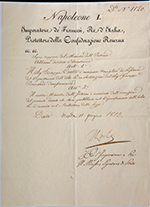 |
Napoleon I - Document as Emperor of the French and King of Italy, With Secretarial Signature (1769-1821) Charismatic French military leader and emperor who conquered much of Europe in the early 19th century. Exceptionally attractive document, in Italian, headed "Emperor of the French, King of Italy…." one page, 11½ x 8¼", June 11, 1913. Secretarial signature by "The Minister Secretary of State." The document appoints Signor Giuseppe Crotti as Prefect Advisor of the Department of High Po and charges the Minister of the Interior with carrying out the order. Ten months later, on April 11, 1814, Napoleon would abdicate the thrones of France and Italy. Document is affixed at corners to larger card stock, easily removed. Very attractive. Estimate $300 - 500
View details and enlarged photo
| Realized
$1,125 |
Lot 152 |
 |
Barton, Clara -- ALS Refusing a Memorial to Herself (1821-1912) Pioneering nurse who founded the American Red Cross. She often served on the front lines during the American Civil War and was known as the "Angel of the Battlefield" and the "American Nightingale." Autograph letter signed "Clara Barton," 4 pages on a bifolium (two conjoined sheets), 6½ x 5¼", Glen Echo (Maryland), May 12, 1906. To Mr. Wells, in part: "…It would be perfectly right if I had passed over, leaving only my memory here…but unfortunately, I am still living, and that asks people to give money to erect a memorial for me, while alive….let the request go to others for the headquarters - and fund…but not for me, nor my memorial….what a handle this would give my ill-natured friends….You would not like Mrs. [Mabel Thorp] Boardman [she led the faction that ousted Barton from the presidency of the Red Cross in 1904]…to be wearing that strand into one of her lectures already full of instruction for the people concerning my misdoings. The request for financial aid must not be for a memorial for me but for the institution we wish to establish and that will constitute the memorial…." Fine condition. Signed vertically in the right margin of page 4. After resigning from The Red Cross in 1904, Barton formed the National Aid Society, which later became part of the Red Cross. Barton published her autobiography in 1907, titled The Story of My Childhood. Estimate $1,000 - 1,250
View details and enlarged photos
| Realized
$625 |
Lot 153 |
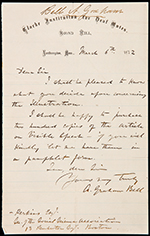 |
Bell, Alexander Graham -- Autograph Letter Signed Re "Visible Speech" (1847-1922) Scientist and inventor, best known for inventing the telephone. Bell's mother and wife were deaf, which had a great influence on his work. He spent years teaching "deaf mutes" and in training instructors to teach them, as well as funding research on deafness--all while perfecting the telephone and working on numerous other inventions. Autograph letter signed "A. Graham Bell," one page, on ruled "Clarke Institution for Deaf Mutes" letterhead, Northampton, Mass., Mar. 6, 1872. To Mr. Perkins, Secretary of the Social Science Association in Boston: "I shall be pleased to know what you decide upon concerning the Illustration. I shall be happy to purchase two hundred copies of the article on visible speech -- if you will kindly let me have them in a pamphlet form." Light toning and one small edge split, else fine.
Bell's father, Melville Bell, was the creator of Visible Speech, a system of symbols to aid people in speaking words in any language, even if they had not heard it. Melville Bell toured the United States in 1868, demonstrating Visible Speech, and in 1870, he was invited by Sarah Fuller, who ran a school for deaf-mutes in Boston, to apply the system. Melville sent Alexander instead and in the spring of 1872, Alexander was invited to the Clarke Institution for Deaf Mutes, where this letter was written, to demonstrate Visible Speech. In the fall of 1872, he opened the School of Vocal Physiology and Mechanics of Speech in Boston. Estimate $1,500 - 2,000
Ex Sotheby's, May 22, 1985.
View details and enlarged photo
| Realized
$960 |
Lot 154 |
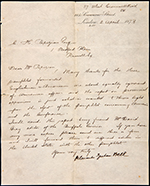 |
Bell, Alexander Graham -- Letter Saying Englishmen & Americans Are Equally Ignorant of Armenian Affairs. Manuscript letter signed "Alexander Graham Bell," one page, 10½ x 8½", on letterhead engraved "445, Cannon Street," which is marked through, and "57 West Cromwell Road" written in, London, Apr. 2, 1878. To C. H. Papazian, thanking him for three pamphlets. In part: "Englishmen & Americans are about equally ignorant of Armenian affairs and the report on provincial oppressions is just what is wanted to throw light upon the object of the pamphlets concerning Armenia and the conference…." Bell intends to send copies to editors in the United States. Normal folds, else fine. Exceptionally bold signature. One of the key issues in treaty negotiations at the Congress of Berlin in 1878, following the victory of Russia over Turkey, was the Armenian Question. It regarded the protection and rights of key minorities in the Ottoman Empire following its defeat. Estimate $800 - 1,200
View details and enlarged photo
| Realized
$3,360 |
Lot 155 |
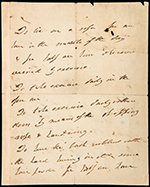 |
Brodie, Benjamin Collins - ADS Giving Instructions For a Patient (1783-1862) British physiologist and surgeon whose name is applied to certain diseases of the bones and joints. His Pathological and Surgical Observations on the Diseases of the Joints (1818) led to fewer amputations and the saving of many limbs. He was the first surgeon to be elected president of the Royal Society (1858). Autograph document signed, "B C Brodie," 2 pages, 9 x 7", no place, Aug. 10, 1834. Brodie writes what seems to be instructions for a patient, in part: "To lie on a sofa for an hour in the middle of the day…To take exercise daily in the open air…In summer to bathe in the open sea on the alternate days, At other times of the year to use a shorter bath of sea water, or salt water every morning. A little (?) in cold weather." Light soiling; a couple of fold separations at edges, one passing through part of "18" in the date; and a few contemporary ink blotches. Boldly penned and signed. Estimate $300 - 500
View details and enlarged photos
| Unsold |
Lot 156 |
 |
Burbank, Luther - An 1891 ALS and a Group of Burbank-Related Items (1849-1926) American botanist, horticulturist and pioneer in agricultural science. Autograph letter signed "Luther Burbank," one page, on his attractive letterhead for "Horticultural Novelties," 9¼ x 5¾", Santa Rosa, Cal., Aug. 1, 1891. To C.M. Silva & Son: "Kindly if possible send amount of bill rendered for trees last winter sent to you…" Some ink transfer to lower portion of letter. With a copy of a booklet, "Luther Burbank, His Methods and Discoveries and their Practical Application. A Synopsis," 12 x 9", 1913. The synopsis of the twelve volumes of Burbanks Works is accompanied by a color illustration from each volume. Also, two photos of Burbank and two postcards featuring him, and a a letter and invitation to Mr. Geo. A. Conrad regarding becoming a member of The Luther Burbank Society. Burbank developed more than 800 strains and varieties of plants over his 55-year career. Estimate $100 - UP
View details and enlarged photo
| Realized
$63 |
Lot 157 |
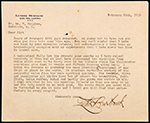 |
Burbank, Luther -- Typed Letter Signed Discussing Numerous Plants (1849-1926) American botanist, horticulturist and pioneer in agricultural science. His prodigious production of fruits, flowers, vegetables, and grasses was the basis for the development of plant breeding into a modern science. Typed letter signed "Luther Burbank," one page, on engraved, personal letterhead, 7 x 8½", Santa Rosa, California, Feb. 24, 1919. To Dr. Wm. Brigham in Honolulu, sending seeds (not present) and discussing a variety of plants. In part: "I understand fully how the Avocado pear sports as I have raised hundreds of them and at last have discovered two varieties from Chile which seem to be hardy even in our climate….I think the Avocado is probably the most promising for experiment of any fruit or plant in the world. It promises marvelous variety of inestimable value from its rare sporting quality. The camphor, olive and eucalyptus all thrive here but…the breadfruit, jackfruit, india rubber, kukui and hardly the guava can thrive at all….I think you will find [the seeds] satisfactory in every respect." Estimate $400 - 600
Ex: Goodspeed's, 1974.
View details and enlarged photo
| Unsold |
Lot 158 |
 |
Cuvier, Baron Georges -- Autograph Manuscript (1769-1832) French naturalist and zoologist who established the sciences of comparative anatomy and paleontology. Autograph manuscript unsigned, one page, 9½ x 7", no place, no date. Headed in English, "Spotted opossum. Philips voy. to new south wales. p.: 147." The body of the manuscript is in French. Partial translation: "note of what is not in the French translation…No. 1. The tail is 9 or 10 inches. It is covered the space of an inch or an inch and a half with hair which is no longer than that of the body. The rest has [hair] that resembles that of the squirrel." A line divides this observation from the following one: "in the description of the opossum belonging to J. Harte, which is found on p. 148 and 149: the body is 18 inches long, without the tail which is 12 [inches]….There are two incisors in the front… and two inside. The testicles are enclosed in a scrotum which hangs between the thighs as in the opossum." Written on laid paper, with a few contemporary ink blotches and a holograph correction; one small mounting remnant in lower left corner. Boldly penned. Estimate $400 - 600
View details and enlarged photo
| Realized
$94 |
Lot 159 |
 |
Darwin, Charles -- Handwritten Page From On the Origin of Species With Holograph Annotations (1809-1882) British naturalist whose scientific studies and subsequent theory of natural selection form the basis of modern evolutionary theory. He published On the Origin of Species by Means of Natural Selection in 1859. Autograph manuscript fragment of On the Origin of Species, one page, apparently the upper half of a 4to sheet of pale blue paper, with holograph revisions. Captioned "Sect. III. Struggle for Existence," and paginated "75" in the upper right corner. Mounted, with letter fragments of other people on verso. One diagonal crease at right edge, else fine.
Darwin writes as follows: "natural vegetation have [these first three words are marked out] been most remarkable, more than is generally seen in going from one quite different soil to another; not only were the proportional numbers of the [a word is marked through] heath-plant wholly changed, but twelve species (not counting grasses & carices) flourished [the word 'there' is marked through] plantation which will ['never' is marked through] not be found on the Heath. The effect on the insects must have been still greater, for six insectivorous birds were very common in the plantation, which [a word is marked through] were not to be seen on the heath, & this was frequented by two or three distinct insectivorous birds." A partial sentence is visible at the lower edge: "been the effect of the…."
This manuscript fragment in Darwin's hand can be found in the paragraph of the printed manuscript which begins: "Many cases are on record showing how complex and unexpected are the checks and relations between organic beings, which have to struggle together in the same country." Darwin gives an example which he observed in Staffordshire, on the estate of a relation, where there were hundreds of acres untouched by man, as well as hundreds of acres enclosed and planted with Scotch fir. He notes the change in the native vegetation of the planted part of the heath.
There are several changes from the handwritten fragment to the printed manuscript: "going" in line two changes to "passing"; the placement of "were" in the third line is moved in front of "wholly changed"; in line five, "will" becomes "could"; and on the next to last line, "this" changes to "the heath."
A draft of sixteen lines brought $200,000 at Sotheby's in 2016. Estimate $70,000 - UP
Ex: Zeitlin & Ver Brugge, Booksellers, 1972.
View details and enlarged photo
| Realized
$102,000 |
Lot 160 |
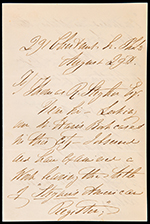 |
Dix, Dorothea -- Autograph Letter Signed (1802-1887) Author, teacher and reformer whose efforts on behalf of the mentally ill and prisoners helped create dozens of new institutions in the United States and in Europe. During the Civil War, she was appointed to organize and outfit the Union Army hospitals and to serve as superintendent of women nurses. Autograph letter signed "D.L. Dix," 3 pages on a bifolium, 7½ x 5", Philadelphia, Aug 29, no year [1820s?]. To Thomas R. Stephens: "Looking over Dr. Hare's Bookcases in this city--I observed and have examined a work bearing the title of 'Stephen's American Register;' 'conducted' …'by James Stryker'…he or yr. self might have pleasure and do good, by adding so interesting a publication to the State Hospital Library at Trenton….you must fully appreciate the value of Books for the care of the convalescent patients." Fine condition. Estimate $600 - 800
View details and enlarged photos
| Unsold |
Lot 161 |
 |
Edison, Thomas -- Signed Annual Report (1847-1931) American inventor whose innovative work in electricity and communication laid the foundation for the modern technical age. Typed document signed "Thomas A. Edison" as a director of The Edison Electric Light Company of Europe, Limited, one page, 11½ x 8", New York, Jan. 1, 1896. Being an Annual Report of the company, which was incorporated in New York on December 23, 1880, and which controlled Edison's electric light patents in Europe, excluding the United Kingdom. Edison signed with two other directors. Among other information, the report notes that the capital stock of the company is two million dollars, the existing debts don't exceed $19,763, and the assets equal at least $30,000. Paper is toned; partial separation at top horizontal fold; uneven lower left margin and closed tear at blank, lower edge. Document is affixed at corners to larger cardstock, easily removed. Edison signed in green ink, with minor ink brushing. Estimate $1,000 - 1,500
View details and enlarged photo
| Unsold |
Lot 162 |
 |
Ehrlich, Paul -- Signed Photo (1854-1915) German Jewish physician and scientist who won the Nobel Prize in Physiology or Medicine (1908) for his contributions to immunology. Among his accomplishments were the development of methods to distinguish between blood types, leading to the ability to diagnose blood diseases; the first effective medicinal treatment for syphilis (Salvarsan); and contributing to the development of an antiserum to combat diphtheria. He coined the term "magic bullet." Postcard photo signed "P. Ehrlich" 5¼ x 3¼", no place, no date. Photo by Dührkaap, Berlin-Hamburg, has some silvering around edges and a few tiny edge chips. A distinguished, right-profile, seated portrait. Estimate $800 - 1,000
Ex Stargardt, ca. 1970.
View details and enlarged photo
| Realized
$1,438 |
Lot 163 |
 |
Einstein, Albert -- Important Autograph Letter Signed: "It is doubtful whether I do not altogether end my connections here" (1879-1955). Nobel Prize winning physicist, famed for determining the theory of relativity. Autograph letter signed "Einstein," one page both sides, in German, 10¾ x 8¼", from his summer house in Caputh (Brandenberg, Germany), Sept. 19, 1932. To Wander Johannes de Haas (1878-1960), a Dutch physicist and an old friend of Einstein's, with over 300 words in Einstein's hand. Accompanied by a full translation. Einstein writes a long personal letter, in fine condition, in which he refers to "atomic mechanics," calls the Nazis "the new Governors" and contemplates leaving his homeland. In part: "…Ehrenfest makes me very sorry that he is so depressed through his feeling of insufficiency with regard to his post, which is objectively unjustified. I actually believe that there are few people who will be as well orientated as he will in our 'law of the jungle' department. Still, for everybody there is a limit where ability to learn comes to an end. I find that a special teaching post for atomic mechanics would be necessary in our universities; much more necessary than a teaching post for physical chemistry. Meanwhile, I also suppose that, for the present, the shortage of funds is making the creation of a new post, even for a limited duration, extraordinarily difficult, if not impossible. I even took the trouble to try what I could, so that these objective and psychological difficulties might be removed. It is impossible for me personally to jump into this gap. First, being an old boy, I already have enough on my back, and secondly I am much too little receptively skilled to be able to be serviceable to others at this time by the transmission of bits of knowledge…. Here, it is yet more difficult than with you and I also have no kind of influence with the new 'Governors.' It is even doubtful whether I do not altogether end my connections here. In any case, I have made myself quite independent, so that I may face anything that may come here with all composure. I regret the things that have happened to me from general human standpoints; what will there be as results, if the military economy starts again here! We feel our helplessness more than ever. Still, there are still good friends and fine people, so that we can feel at home on this earth."
Wander de Haas, to whom Einstein was writing, was married to the daughter of Hendrik Lorentz (1853-1928) a Dutch physicist who derived the transformation equations underpinning Einstein's theory of special relativity. What a small world! Einstein had reason to be concerned about Paul Ehrenfest's depression. A theoretical physicist whom Einstein considered the best teacher he had ever known, Ehrenfest committed suicide on Sept. 25, 1933. In December 1932, three months after writing this letter, Einstein left Caputh for a lecture tour in the United States. He never set foot in Germany again. On January 30, 1933, Hitler became Reich Chancellor and the downward spiral began. Jews were banned from holding public office, including teaching at universities. The Nazis called Einstein's theory of relativity "Jewish physics," sponsored conferences and book burnings to denounce him and his theories, and placed a bounty on his head. His summer home was turned into a Hitler Youth Camp. Einstein accepted a position at the Institute for Advanced Study at Princeton, with which he remained associated until his death. He became an American citizen in 1940. Estimate $15,000 - UP
View details and enlarged photos
| Unsold |
Lot 164 |
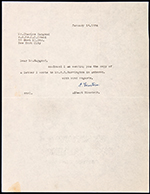 |
Einstein, Albert -- TLS Plus Copy of a TLS With Original Diagram, Equations and Other Annotations. Typed letter signed "A. Einstein" on letterhead with blind embossed "A. Einstein, 112, Mercer Street, Princeton, New Jersey, U.S.A.," one page, 11 x 8", Jan. 16, 1954. To Mr. Charles Hapgood in New York City, enclosing a carbon copy of a letter he wrote to Mr. William Farrington, Dept. of Geology and Mineralogy at the University of Massachusetts, on Hapgood's theory of earth crust replacement. The two yellow pages hold original annotations in Einstein's hand: an original diagram, three equations, a term representing tangential force, and five handwritten angles--three for "beta" and two for "phi," as well as one holograph word.
Einstein wrote to Farrington: "When I read your letter…I too had…the impression that I had overestimated erroneously the dislocating force on the solid crust due to an additional (excentrically located) mass. More careful consideration has shown me, however, that, paradoxically, your argument is not conclusive." Einstein goes on to explain and illustrate, concluding, "I think that the idea of Mr. Hapgood has to be taken quite seriously."
Einstein wrote a foreword to Hapgood's The Earth's Shifting Crust, which was published in 1958, Hapgood's book denied the existence of continental drift, speculating that the ice mass at one or both poles over-accumulates and destabilizes the Earth's rotational balance, causing slippage of all or much of Earth's outer crust around the Earth's core, which retains its axial orientation. Fine. Estimate $10,000 - UP
View details and enlarged photos
| Realized
$10,938 |
Lot 165 |
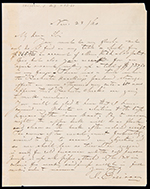 |
Ericsson, John - ALS Discussing His "Iron Boat" (1803-1889), Swedish-born American naval engineer and inventor who built the first armoured turret warship, the Monitor, and developed the screw propeller. Autograph letter signed "J. Ericsson," one page, 9¾ x 7¾", no place, Nov. 23, 1860. To an unidentified correspondent, "You must be very flush--not only do I find on my table a check for $365.75…but also your receipt for an equal amount….You will be glad to hear that I have carried my point in selection to the top houses of the iron boat. By to morrow night the upper deck will be as flush and clean as the back of the…receipt. The owner of the vessel, most fortunately, arrives today to second my objections so we shall lose no time. The engine is ready for cold pressure and the cold pressure pump is up and pipes attached. The (?) for working said pump will be in full working order to morrow." Fine condition.
On August 3, 1861, President Lincoln signed Bill 36 into law, establishing the Ironclad Board and authorizing $1.5 million for the construction of ironclad ships. On March 9, 1862, the first battle between ironclad warships took place. The USS Monitor and the former USS Merrimack (newly christened CSS Virginia) fought to a standstill. The U.S. Government soon placed an order for more ironclads, which played an important role in the blockade of the Confederacy. Estimate $1,500 - 2,000
View details and enlarged photo
| Realized
$1,375 |
Lot 166 |
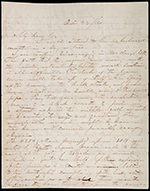 |
Ericsson, John -- Giving Detailed Instructions (1803-1889) Swedish-born American naval engineer and inventor who built the first armoured turret warship and developed the screw propeller. Autograph Letter Signed ("J. Ericsson"), 3 pages, recto and verso, 4to (conjoining leaves), no place, Oct. 22, 1860. Light toning; some restoration at horizontal folds. Ericsson writes to an unnamed colleague in the days leading up to the Civil War, giving detailed advice. In part: "I see nothing discouraging in McClary�s letter. The fact that the engines run away with the work, not withstanding the small suction, is all sufficient. The leak of the brass lining will take up of itself. The spring of the braces, on the back strut, only proves heavy suction, no doubt owing to the small pipe. Pray tell your men to send the braces to a black smith to put in a stout rod in the middle, full an inch in diameter, the red one good and strong enough….". Estimate $900 - 1,200
View details and enlarged photos
| Realized
$1,313 |
Lot 167 |
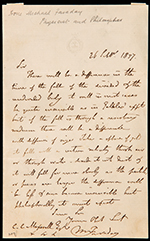 |
Faraday, Michael -- Autograph Letter Signed Re Fall of a Divided vs. Undivided Body (1791-1867) English physicist and chemist whose many experiments contributed greatly to the understanding of electromagnetism. His main discoveries include the principles underlying electromagnetic induction, diamagnetism and electrolysis. He is considered one of the greatest scientists of all time. Autograph letter signed "M Faraday," one page, with blind, embossed seal of the Royal Institution of Great Britain, 7 x 4¼, no place, Sept. 26, 1857. To C.C. Maxwell, Esq.: "There will be a difference in the time of the fall of the divided & the undivided body it will in most cases be quite invisible as in Gallileo expt but if the fall is through a resisting medium there will be a difference with difference of size. Take a sphere of gold it falls with a certain velocity through air or through water….(?) it into dust & it will fall far more slowly as the particles, or pieces are larger the difference will be less & soon become invisible but philosophically it must exist." Light toning and two small mounting remnants on verso of integral blank leaf, else fine. Estimate $1,000 - 1,500
View details and enlarged photo
| Realized
$1,380 |
Lot 168 |
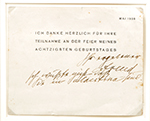 |
Freud, Sigmund - Autograph Note Signed Mentioning Palestine (1856-1939) Austrian neurologist and the founder of psychoanalysis. Autograph note signed "Ihr ergebener Freud [Your devoted Freud]" at the bottom of a May 1936 printed acknowledgement in German of wishes received for his 80th birthday, 4½ x 6", no place. Freud adds two lines in German in his hand, "Ich wußte nicht das Sie in Palaestina sind [I did not know you are in Palestine]." Matted with a name plaque and an image of Freud and framed to an overall size of 15½ x 19¾". Fine condition.
After Hitler came to power on January 30, 1933, many German Jews saw the writing on the wall and emigrated, some 60,000 of them going to Palestine during the 1930s. On March 12, 1938, the Germans marched into Austria and on June 4, 1938, Freud and his family fled to London. Estimate $3,000 - 5,000
View details and enlarged photo
| Realized
$2,400 |
Lot 169 |
 |
Howe, Samuel Gridley - ALS re an "Idiotic Boy" Who May Be Qualified for Howe's School (1801-1876, Boston), American physician, educator, and abolitionist as well as the founding director of the New-England Institution for the Education of the Blind (later known as the Perkins School for the Blind) and the Massachusetts School for Idiotic and Feeble-Minded Youth. Autograph letter signed "S.G. Howe," one page, on "Perkins' Institution, and Massachusetts Asylum for the Blind" letterhead, Boston, Apr. 1, 1862. To A.P. Peabody, regarding "an idiotic boy in whom you are kindly interested." He is told to get the mother to fill out the blanks in a paper he is enclosing (not present), and "I shall be able to judge by the answers whether the lad is a proper subject for the school. If he is I will take the necessary steps to procure his admission. It will be necessary that his friends provide his clothing but they will be put to no further expense." A couple of small edge splits and chips, else fine. At that time, intellectually disabled people were referred to as "idiotic" and "feeble minded." Estimate $300 - 500
Ex: Paul Richards, ca. 1985.
View details and enlarged photo
| Unsold |
Lot 170 |
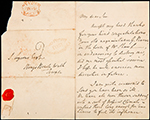 |
Jenner, Edward - Autograph Letter Signed (1749-1823) English country doctor who introduced the vaccine for smallpox. He coined the term "virus" and was the founder of immunology. Autograph letter signed "Edwd. Jenner," 2 pages, 8 x 5", 15 Bedford Place (London), Aug. 3, 1807. Holograph integral address leaf has handstamp, "Two-Penny Post Southampton," script "2" and red shield-shaped clock stamp, as well as most of the red wax seal. To a barrister friend at Kings Beach Walk, Temple, London. In part, "Accept my best thanks for your kind congratulations. Your old acquaintance G. Pearson, in the form of Mr. Shaw…in endeavoring to destroy me, did me most essential service. I hope he will exercise more discretion in future. I am quite concern'd to find you have been so ill. We have all been thrown suddenly into a sort of tropical climate & confind there long enough for our Livers to feel its influence. You have been pursuing the best of all courses under such circumstances. The occasional use of mild purgatives, with the repetition of small Blisters to the side, may still be necessary." Fine condition.
In the 18th century, one in ten deaths was caused by smallpox and those who survived were often horribly scarred. Jenner had been awarded £10,000 by Parliament in 1802 and in 1807 he was awarded £20,000; it was for the latter award that his friend was congratulating him. Jenner was made Physician Extraordinary to the King (George IV) in 1821 but he was never knighted. Estimate $2,000 - UP
View details and enlarged photos
| Realized
$1,250 |
Lot 171 |
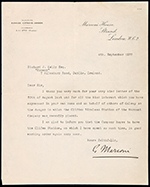 |
Marconi, Guglielmo -- 1922 TLS Re Damage to Irish Wireless Station by the IRA (1874-1937) Italian physicist and inventor who developed, demonstrated and marketed the first successful long-distance wireless telegraph and in 1901 broadcast the first transatlantic radio signal. In 1909 he shared the Nobel Prize for Physics. Typed letter signed "G Marconi," one page, on Marconi House letterhead, 10 x 8", London, Sept., 4, 1922. To Richard J. Kelly in Dublin, thanking him for "all the kind interest which you have expressed in your own name and on behalf of others of Galway in the danger in which the Clifden Wireless Station of the Marconi Company was recently placed. I am glad to inform you that the Company hopes to have the Clifen [sic] Station, on which I have spent so much time, in good working order again soon." Fine condition. Accompanied by a 1925 letter to Mr. Kelly by Marconi's private secretary enclosing newspaper cuttings (not present) "with reference to the destroyment of the Marconi Wireless Station at Clifden by the Sinn Feiners and the consequent loss to Ireland who is now reduced to communicate to America through England."
The station at Clifden (County Galway) opened officially in 1907 with signalling between Clifden and Glace Bay, Nova Scotia. The station was attacked in 1922 by Irish revolutionaries and some buildings were seized and damaged. Marconi was refused compensation by the new Irish Free State government and the station closed shortly thereafter. Estimate $900 - 1,200
View details and enlarged photo
| Realized
$844 |
Lot 172 |
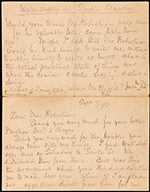 |
Nightingale, Florence -- Autograph Notes & Two Letter Drafts, One Signed (1820-1910) British nurse, statistician, and social reformer; the founder of modern nursing. She gained prominence for her work during the Crimean War, where she became known as "The Lady With the Lamp." Draft of an autograph letter signed "F Nightingale," along with other instructions in her hand, 4 pages, 7 x 4½" (on two conjoined sheets), no place, Sept. 7 (18)92. The draft is to Mrs. Robertson, thanking her for "the trouble you always take with my things," discussing the distribution of some eggs and mentioning St. Thomas, the hospital where Nightingale founded the Nightingale School and Home for Nurses in 1860. The two sheets also have notes headed "Water-supply &c. Steeple Claydon" and signed "FN". The notes give instructions to ask Mr. Robertson to "write at length, what is the actual practical state of things now about the drainage & water-supply…." Another draft, headed Mr. Gough and marked "Private" concludes, "But when will Mr. Gough cease this mystery, & announce that he is going? & send in his resignation?" The initials "P.T.O." at the end may be the person to whom the letter should be sent. Light soiling and some fold wear, else fine. Estimate $600 - 800
View details and enlarged photos
| Realized
$690 |
Lot 173 |
 |
Paget, James - ALS re a Report Illustrating the General Pathology of Contagions (1814-1899) English surgeon and pathologist considered one of the founders of scientific medical pathology. He was a professor at the Royal College of Surgeons and several medical conditions were named for him. His works include Lectures on Tumours (1851) and Lectures on Surgical Pathology (1853). He was elected a Fellow of the Royal Society in 1851. Autograph letter signed "James Paget," 2 pages (pages 1 and 2 of a bifolium), on stationery engraved "1, Harewood Place, Hanover Square," 7 x 4½", Jan. 9, 1884. To Dr. Masters, asking if he was going to publish in the Gardener's Chronicle a report by Dr. Beijerinck on "the Germ-disease." which had been issued by the Academy of Sciences of Amsterdam. "I want to send a notice of these observations, so far as they may illustrate the general pathology of contagions, to one of our Medical Journals and I should be glad to be able to refer its readers to some place in which they may send a report of other parts of Dr. Beijerinck's essay in something easier than Dutch…." Minor soiling and small split at juncture of pages, affecting nothing, else fine. Estimate $400 - 600
View details and enlarged photos
| Unsold |
Lot 174 |
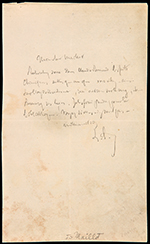 |
Pasteur, Louis -- Autograph Letter Signed (1822-1895) Microbiologist and chemist renowned for his discoveries of the principles of vaccination, microbial fermentation and pasteurization. Autograph letter signed with his initials, "L.P.," one page, in French, 8 x 5", no place, no date (c. 1865-1870). Pasteur writes to "My dear Maillot" (Eugène Maillot, 1841-89), who entered Pasteur's lab as an associate researcher in 1865, when Pasteur was asked to go to the south of France to discover the cause of and to eradicate a disease which was decimating the silk-worm industry. Pasteur spent five years working on the problem and succeeded in steming the disease, which was caused by a mushroom, Nosema bombycis. Maillot dedicated a book he published in 1885, "Lessons on the Mulberry Silk Worm," to Pasteur.
Pasteur's letter is hurriedly written and difficult to read, but it begins by instructing Maillot, "Look in Claude Bernard for the chemical facts…." Claude Bernard (1813-78) was a physiologist who, along with Pasteur, was a pioneer in establishing the scientific method--using blind experiments to ensure the objectivity of the experiment. Fine condition. Written in pencil. "To Maillot" is written in another hand at lower edge. Estimate $1,000 - 1,500
View details and enlarged photo
| Realized
$719 |
Lot 175 |
 |
Steinmetz, Charles Proteus -- Signed Check (1865-1923) American mathematician, electrical engineer, and technological pioneer who was born Karl August Rudolf Steinmetz in Breslau, Prussia. His ideas on alternating current systems helped inaugurate the electrical era in the United States. Check signed "Charles P. Steinmetz" and filled out in his hand, 2¾ x 6¼", Schenectady, N.Y., July 1, 1907. Written on The Schenectady Trust Company and paid to J.T. & D. E. Lyon in the amount of $1961.34. Fine condition. Stamp cancellations on verso. Punch cancellation affects body of check but barely touches the capital letters in Steinmetz' bold signature. In 1893, Thomas Edison hired Steinmetz as a consulting engineer for General Electric Company, where he worked for the rest of his life. Estimate $250 - 300
Ex B.C. West Autographs, 11/22/74.
View details and enlarged photo
| Unsold |
Lot 176 |
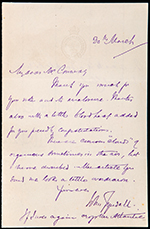 |
Tyndall, John -- Autograph Letter Signed (1820-1893) Irish experimental physicist. He was professor of physics at the Royal Institution of Great Britain in London from 1853 to 1887. Autograph letter signed "John Tyndall," one page and two lines, on blind embossed letterhead of the Royal Institution of Great Britain, 7 x 4½" (London), Mar. 30, no year. To Mr. Conway, "Thank you much for your note and its enclosure. Thanks also with a little bloodleaf added for your friendly congratulations. There are curious 'clouds' of organisms sometimes in the air….The article…looks a little overdrawn." After his signature, he adds a note that he will make it a point to visit his friends at Columbus if he crosses the Atlantic again. Penned and signed in purple ink. Fine. Estimate $400 - 600
Ex: B.C. West Autographs, 1974.
View details and enlarged photos
| Realized
$250 |
Lot 177 |
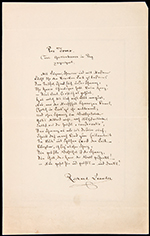 |
von Volkmann, Richard -- Autograph Manuscript Poem Signed With His Pen Name, Richard Leander (1830-1889) Considered the father of orthopedic surgery. He pioneered Lister's antiseptic procedures in Germany and was the lead physician for the German military during two wars. Volkmann's contracture and the Hueter-Volkmann law are named after him. He also wrote books of children's fairy tales and poems under the name of Richard Leander.
Autograph poem signed "Richard Leander," one page, 13½ x 8½", in German, no place, no date (between 1878 and 1889). Titled "Pro domo,"(For Home), the poem is about pain and is dedicated to Carl Gussenbauer in Prague. Gussenbauer was a pioneer in pancreatic surgery, who had trained with von Volkmann under Theodor Billroth and was a professor at the University of Prague from 1878 to 1894. Gussenbauer would have been aware of the painful spinal condition from which von Volkmann suffered for almost 20 years.
The poem has18 lines and is beautifully penned and signed. It begins, "Mit Sägan, Scheeren und mit Messern / Sucht Ihr den kranken Leib zu bessern. / Den Teufel schiert Euch unser Schmerz: / Ihr Herrn Chirurgen habt kein Herz!…." [Wth saws scissors and knives / You attempt to save the battered body. /The Devil serves us pain. / You, Master Surgeons, are heartless!"]. Dr. von Volkmann knew whereof he spoke. This brilliant, much-respected doctor died at the young age of 59.
The poem was published in JANUS 45, 1-2 (1941) under the pen name of Richard Leander. Fine condition. A typed German transcript and an English translation accompany the poem. Available upon request. Estimate $800 - 1,000
View details and enlarged photo
| Realized
$720 |
Lot 178 |
 |
von Volkmann, Richard -- Handwritten Notes & Sketches For an 1888 Lecture (1830-1889) Considered the father of orthopedic surgery. He pioneered Lister's antiseptic procedures in Germany and was the lead physician for the German military during two wars. Volkmann's Contracture and the Hueter-Volkmann Law are named after him. He also wrote books of children's fairy tales and poems under the name of Richard Leander.
Autograph notes and eight sketches prepared for a lecture given in 1888, 4 pages (front and back of 2 sheets), 13 x 8¼, in German, no place, 1888. One page is titled "Ankylosen - Anwachsung der Patella in Flexionstellung" [Anchylosis - Increase of patella in flexion position]. Anchylosis is an abnormal stiffening and immobility of a joint due to fusion of the bones. Dr. von Volkmann drew a large sketch illustrating fusion of the tibia and the femur, followed by his notes; a second sketch is on the verso.
Another page is headed "Elongation of the Femoral Condyles" and holds six sketches, and Dr. von Volkmann's notes, some of which are: "Already shown in schematic wood sections in the Berlinder clinical week-paper in a work on the treatment of the knee joint anchylosis by simple osteotomy above or under the knee joint, or by double osteotomy, at the same time above and below the knee joint." Four sketches follow: "Osteotomy above the knee, Osteotomy below the knee, Osteotomy above and below the knee." His notes continue: "Ratios of the knee joint in knee joint anchylosis of individuals which grow strongly afterwards. Hypertrophic elongation of the femoral condyles as a result of a lack of articular pain. 2 Sketches: Legend: will initially be held back by untrained persons for the very ordinary luxatio or subluxatio. The ligg. lateralia which, to a certain extent, form the radius sector are now much too short. If the breakage is now carried out by force, then either
1.) a total dislocation
2.) or favorable case (s) with low elongation the femoral condyles, which are softened by loss … (atrophic, lipomarian) are infused, squeezed together. Then the tibia and the femur could be placed in a straight position (a kind of indentation (?) or a 'kink'."
Light overall toning; toned line at edges from previous framing. As yet unpublished except for facsimile in JANUS 43, 324 and 325 (1939). Estimate $3,000 - 5,000
Ex: Stargardt, c. 1970.
View details and enlarged photos
| Realized
$1,800 |
Lot 179 |
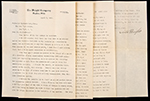 |
Wright, Orville -- Fantastic Content 3½-Page TLS on the Pendulum as a Stabilizing Agent, Soaring Experiments, & Mentions His Brother's Death (1871-1948) Younger of the Wright Brothers, the inventors and aviation pioneers who were the first to achieve powered, controlled and sustained flight (in 1903 -- with Orville at the stick) and flew the first practical airplane (in 1905). Following Wilbur Wright's death in 1912, Orville continued to experiment and innovate, serving as one of the foremost aeronautics authorities of the age. Typed letter signed "Orville Wright," 3½ pages, on "The Wright Company / Dayton, Ohio" letterhead, 11 x 8½", April 7, 1915. To Frederick Epplesheimer at The New York Herald, disagreeing with a group of scientific and engineering societies who had reported that the pendulum was not a proper stabilizing agent. A signed passport-size photo of Epplesheimer is present.
Wright says, in part: "I believe the pendulum is in itself an almost perfect device for preserving lateral balance. I have flown by the hour with such a device, a good deal of the time in winds of fifteen to twenty miles, yet I was unable to detect any case in which the pendulum did not give the proper direction in the operation of the machine. The only troubles we had with the device was in the electrical mechanism between the pendulum and the aeroplane controls….I now have a machine at our flying field so equipped that when the weather becomes suitable and I have the time, I expect to resume the experiments. The pendulum shows exactly the proper bank the machine should take in making a turn. In this respect it is very far ahead of a machine that is manually controlled, because the pendulum operates in slight changes of angle, which the aviator is not able to feel. I note what you say in regard to soaring and hovering flights. A flying machine would only be able to hover in one spot when flying in a strong wind. I had hoped to resume the soaring experiments before this time, but since my brother's death, legal and other business matters have prevented me from doing so. It is a question whether man will ever be able to soar like a bird, on account of his greater spread of wings. It is evident that a bird with a wing spread of only five or six feet can circle in a space not more than a fifth or a sixth of that which would be required for a man-carrying flying machine…." He goes on to explain this and then describes what occurred in Montgomery, Alabama in 1910 when he was flying with a power machine and the machine got held up by a trend of air: "I had made a flight to a height of about 3,000 feet and was descending at a rather rapid rate with the power turned to its lowest, when at a height of about 1,500 feet, I got into a rising trend of air which stopped all progress downward, although I pointed the machine downward as steep as I considered safe. I flew in this way without being able to decrease my height for a space of five minutes, until finally I began to become freightened…The conditions met with in this case were certainly unusual. I have never met with anything like this in all of my flying about Dayton. I think that either you or Mr. Stiles told me…that Curtiss had adopted the single acting aileron system of control in his school machines. It seems that he has had to abandon it and now is back to the old style of control again in all of the machines at San Diego…." Estimate $7,500 - UP
Ex Charles Hamilton auction, March 3, 1974.
View details and enlarged photo
| Realized
$6,300 |
Lot 180 |
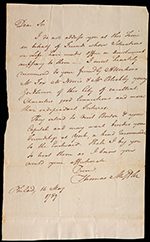 |
Mifflin, Thomas -- Autograph Letter Signed as Governor (1744-1800) President of the Continental Congress (1783-84), Signer of the U.S. Constitution, and First Governor of Pennsylvania (1788-99). Autograph letter signed "Thomas Mifflin" as Governor, one page, on laid watermarked paper, 12¾ x 7¾", Philadelphia, May 16, 1789. A letter of introduction to an unknown person in Boston, commending to his attention Mr. Fox, Mr. Norris, and Mr. Bleckly, "young gentlemen of this City of excellent Character good Connections and more than independent Fortunes. They intend to visit Boston & your Capital and may want besides your Friendship at York, a kind recommendation to the Eastward." Fine condition. Estimate $500 - 600
View details and enlarged photo
| Realized
$480 |
Lot 181 |
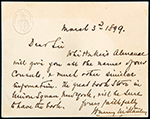 |
Stanley, Henry M. - Autograph Letter Signed by the African Explorer (1841-1904) Journalist and explorer famous for his exploration of central Africa and his search for missionary and explorer David Livingstone. Upon finding Livingstone, Stanley supposedly asked, "Dr. Livingstone, I presume?" Autograph letter signed "Henry M. Stanley" on a 3¾ x 4¾" card, no place, Mar. 3, 1899. Answering a query from an unknown person, Stanley writes: "Whittaker's Almanac will give you all the names of our Consuls, & much other similar information. The great book store in Union Square, New York, will be sure to have the book." Boldly penned and signed. Estimate $100 - 200
View details and enlarged photo
| Realized
$188 |
Lot 182 |
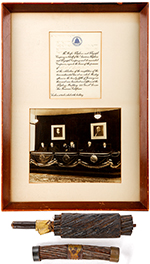 |
(Inventors: Cyrus Field and Alexander Graham Bell). Cyrus Fields: A 4" piece of the Atlantic telegraph cable which was laid in early August 1858 nearly 2000 miles across the at a depth often of more than two miles. With a printed COA from Cyrus Fields, New York, Aug. 21, 1858, certifying that this is part of the balance of the cable from the U.S.S. "Niagara" which he had sold to Tiffany & Co. A plaque on the cable says it is guaranteed by Tiffany & Co. Also, a 5¾" section of the first Trans-Pacific cable to Guam, with vintage tag from Langley & Michaels Co. in San Francisco.
Alexander Graham Bell: Vintage photo, 7½ x 9¼", showing Thomas Watson making the first transcontinental phone call with Alexander Graham Bell in New York, Jan. 25, 1915. Watson is in San Francisco and is surrounded by officers of Pacific Telephone and Telegraph; matted with an invitation to a celebration of the completion of the transcontinental line on Jan. 25, 1915, and framed to an overall size of 20½ x 14"½. Estimate $400 - 600
View details and enlarged photo
| Realized
$330 |
Lot 183 |
 |
Common Sense by Thomas Paine - Mid 19th Century Edition. Common Sense: Addressed to the Inhabitants of America, on the Following Interesting Subjects, Viz.:--1.--Of the Origin and Design of Government in General; With Concise Remarks on the English Constitution. II.--Of Monarchy and Hereditary Succession. III.--Thoughts on the Present State of American Affairs. IV.--Of the Present Ability of America; With Some Miscellaneous Reflections. With an Appendix, on the Duty of Immediate Separation. By Thomas Paine. Boston : J.P. Mendum, At the Office of the Boston Investigator, [1850?], 48pp., With small paper loss to yellow wrappers. Light toning throughout. Estimate $200 - UP
View details and enlarged photo
| Unsold |
Lot 184 |
|
Withdrawn
| Unsold |
Lot 185 |
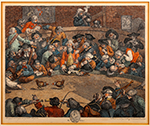 |
William Hogarth Etching and Engraving: Pit Ticket. "Designed and Engrav'd by Will.m Hogarth…Publish'd according to Act of Parliament Nov. 5th 1759." 13 x 15½", matted and framed to 19½ x 22½". Light toning, darker at edges of margins. Not examined out of frame. A cross-section of men from all classes and professions wagers their money on cock fighting, the "Royal Sport." A symbolically-blind nobleman at the center accepts the bets. William Hogarth (1697-1794) was famous for his paintings, as well as his engravings. He created anecdotal sets which satirized society. Estimate $300 - 500
View details and enlarged photo
| Realized
$120 |
Lot 186 |
 |
Younger, Cole; Autograph Letter Signed (1844-1916) Thomas Coleman Younger was a bandit who was a member of the Confederate guerrilla group, Quantrill's Guerrillas, during the Civil War. He joined with Jesse James and formed the James-Younger band, which was composed of Jesse and Frank James and Cole and his two brothers, James and Robert. The Younger and James brothers terrorized Missouri and the surrounding states with a string of bank and train robberies during the 1860s and 70s. Following a failed bank raid in Northfield, MN, on September 7, 1876, the James brothers escaped back to Missouri but all three Younger brothers were shot and captured; all three were sentenced to life imprisonment. Robert died in 1889 of tuberculosis and Cole and James were paroled in 1901. James committed suicide in 1902. Cole was pardoned in 1903 and remained a law-abiding citizen for the rest of his life. Cole eventually reunited with Frank James in a touring Wild West show (Jesse having been assassinated in 1882 by that "dirty coward" Bob Ford). Toward the end of his life, Cole went on the lecture circuit preaching the evils of crime. At the time of this letter, Younger was with the Al Nicols Street Carnival but he wanted to quit show business for a job with an insurance company.
Autograph letter signed, one page, 7¾ x 6", and two partial pages, each 3¼ x 6", laid to front and back of another page, Kansas City, Mo. (paper is imprinted Cameron, Mo.), June 27, 1908. To Harry Hoffman, in part: "We have been figuring on making a jump to North West Canada but suppose it is all off and we will play Gallatin, Mo. next month. Thank God, we have had one week of sunshine and if it will only continue we will pull out all right I hope. I see by the papers there is a company in K.C. organizing a new insurance company if convenient find out what they amount to if good see if you cannot get some one to convince them that I would be a good man to represent them at Lee's Summit and the south side of Jackson County. I believe I could get more for them than any one I know. I am tyred of show business and will quit this fall….Remember me kindly to all friends I will be at home in October….Love to all and many kisses to the children. Your friend Cole Younger."
Some professional fold repairs on verso of first page. A few words of text on partial pages are missing. Parts of the text have been professionally enhanced, as several large iodine stains previously interfered with legibility. The signature is dark and crisp. Accompanied by a notarized letter from Harry Hoffman, the recipient of this letter, certifying that he was "on a friendly basis for many years" with Younger. Also included are four other letters written by Mr. Hoffman to Mr. John A. Fischbach, the man to whom he sold this letter in 1959, and a transcription of the Cole Younger letter, as well as three photos of Cole, one of Robert Younger, and five envelopes. A rare relic of the Wild West. Estimate $3,000 - 5,000
View details and enlarged photo
| Realized
$1,800 |
|
|